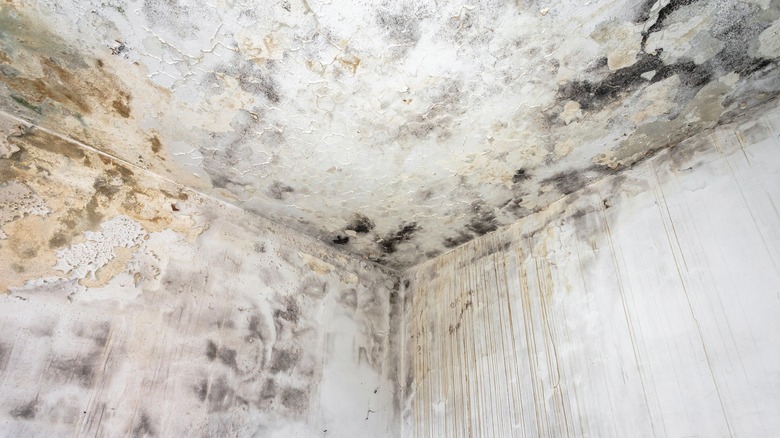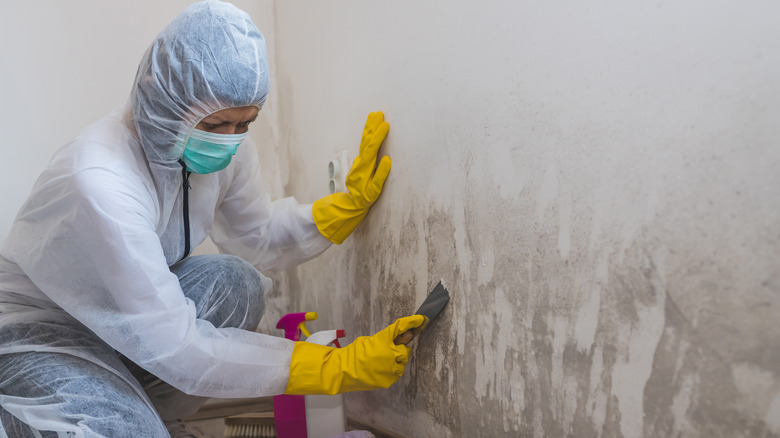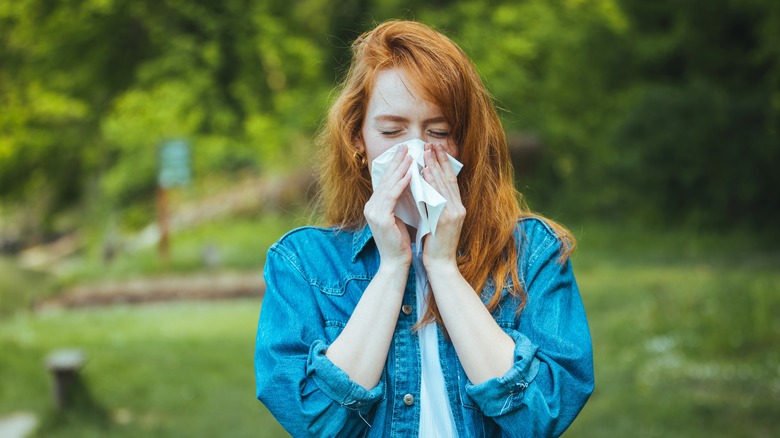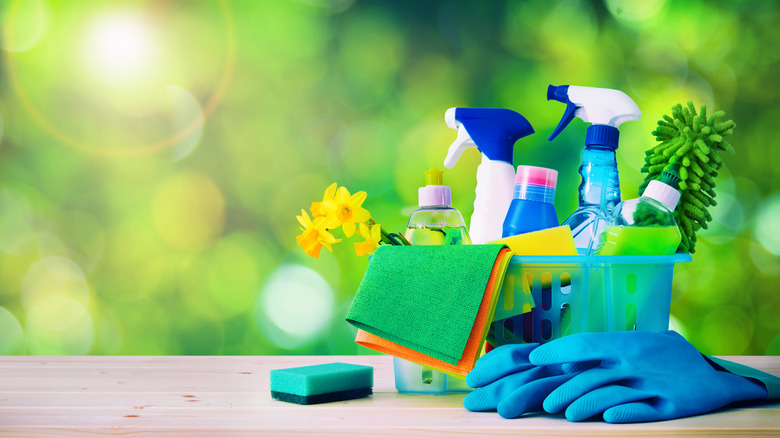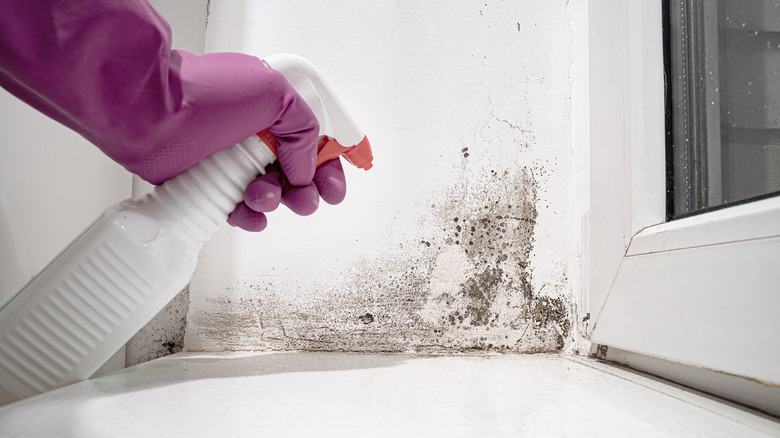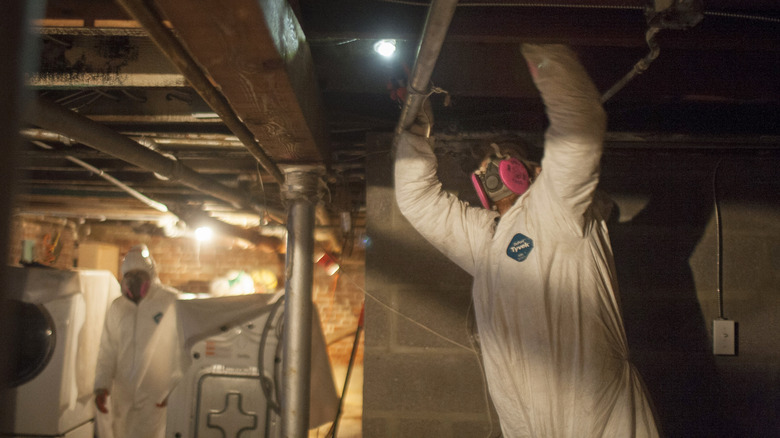Michael Rubino Of The Change The Air Foundation On The Importance Of Your Home's Air Quality - Exclusive Interview
Your home should be your castle and your retreat — the one place you feel safest and most comfortable. But if you've been feeling off for a while and can't figure out why, your home may be the culprit — or more specifically, the toxic mold that may be growing in your home. Mold is much more than a cosmetic issue, and according to mold remediation specialist Michael Rubino, toxic mold spores, if inhaled, can contribute to serious ailments ranging from brain fog to migraines to hormone and fertility issues. While mold infestations can erupt at any time of year, summer storms and humidity can be exacerbating factors.
Initially trained in construction and disaster restoration, Rubino has built a unique career bridging the gap between home maintenance and health advocacy. His restoration company, HomeCleanse, coordinates with medical professionals to offer specialized mold remediation services designed not only to remove mold and bacteria but also to ensure safe and healthy indoor air quality.
In addition, Rubino recently launched the Change the Air Foundation, an advocacy organization to build awareness about the impact of water damage and mold on indoor air quality and health and support those impacted by household mold. In an exclusive email interview, Rubino talked to us about his professional journey and the steps you can take to keep your home safe and healthy.
Household mold is a more serious problem than most people think
Most people think of household mold as just ugly and smelly. What makes it more dangerous than that?
Mold is considered an indoor contaminant for a few reasons. As a colony grows, it releases microscopic particles called spores into the surrounding environment. Measured in microns, these spores are small enough that they can be inhaled, absorbed, and ingested into the body.
The longer a colony grows in a home, the more spores will build up in that area, lowering the indoor air quality and covering surfaces within the home. This results in an increasing number of foreign particles entering the bodies of anyone spending time in the building. Their immune system will work to continually get rid of them, but it can get overwhelmed and/or malfunction, leading to health issues. Not to mention, indoor mold growth also increases the chances of another colony developing elsewhere due to the high number of spores in the space, further contaminating the space.
Some species of mold can also create microscopic toxins called mycotoxins when threatened. These particles are naturally toxic to the human body and can also cause a wide range of chronic health issues. Interestingly, the FDA regulates levels of mycotoxins in our food products, but there are no regulations for our indoor spaces.
Working in water damage restoration made Michael Rubino realize mold was a serious problem
How did you become interested in indoor air quality and mold remediation, and why did this issue resonate with you?
I'm from New Jersey originally, and my father was in the fire restoration industry. I started working for his company, and since fires are put out with water, I began to see a high number of homes with mold contamination while working on projects. That being said, the major tipping point that started me down the path of indoor air quality and mold remediation was Hurricane Sandy. The storm decimated the Northeast, leading to a high number of flooded homes.
As we helped these individuals, I witnessed the enormous impact these water-damaged homes had on the health of those who were living inside of them. That's where my passion for this issue began as more and more lives were torn apart by toxic indoor environments. I also began to notice how insurance companies handled the situations due to their lack of education and awareness, which meant many of these people weren't able to properly handle the situations in their homes. That ultimately led to their feeling increasingly unwell the longer they remained in the toxic space.
Another piece of the puzzle I realized is that anyone coming to us for help after the hurricane often already had remediation done to resolve the issues, but they were still feeling sick. That was the "ah-ha moment" that led to me recognize that the normal way of completing a remediation project wasn't working. You can't just slap a cosmetic band-aid on an indoor contamination issue — the growth will grow back or toxic particles will continue to exist in the space. Essentially, there was no standard for the industry, which was triggering all of these systemic and chronic issues.
This led me down the rabbit hole of diving into science and understanding more about these indoor contaminants. I was dedicated to figuring out how to properly remove them so that families could move back into their homes and live healthier lives. Eventually, I put all of the pieces together and created a protocol that can effectively eliminate contamination (including bacteria and mycotoxins) and resolve the issue that led to the problem in the first place. This process is what HomeCleanse is founded on and how we help create healthy home environments for our clients.
These health problems could be due to mold
What are some of the health problems caused by household mold?
The tricky thing about mold is that no two people respond to exposure the same way. One person could only experience lower energy levels, while another has over 30 symptoms or develops an autoimmune condition. A lack of research dedicated to this topic, on top of the lack of awareness, also makes it harder to pinpoint if exposure to these contaminants is the problem.
That being said, a few common symptoms I've seen my clients suffer from include:
- Headaches and migraines
- Allergy symptoms and persistent colds
- Chronic fatigue and decreased physical mobility
- Hives, eczema, skin rashes
- Brain fog and cognitive difficulty
- Hormone disruption and infertility
One of the main things to keep in mind is that any symptom experienced will be chronic because they're living inside of the problem. As long as the exposure continues, those particles will keep building up in the body and trigger those adverse reactions.
We're also noticing that many autoimmune conditions are triggered or work in tandem with mold exposure as the immune system is compromised. A few include Lyme disease, Hashimoto's, mast cell activation syndrome, and chronic fatigue syndrome.
Here's how you can keep your home mold free
How can you tell if your medical condition was caused by mold or by something else?
A qualified medical professional who is familiar with mold will be able to run a series of tests that can help alert them to environmental exposure as the root cause of the problem or part of the issue. This often includes blood work, mycotoxin testing, visual contrast sensitivity, and genetics. Keep in mind that not all medical professionals are aware of mold's ability to impact the body and how to treat it. It's important to find someone who is experienced in helping detox the body after these exposures.
What can people do to prevent the growth of mold in their homes?
The primary goals of mold prevention are to reduce moisture in the home and actively work to remove as many spores as possible that have made their way inside. Thanks to modern building practices pushing for net-zero energy efficiency, there's very little airflow between indoor and outdoor environments, so it's up to us to forcibly remove any particulate matter that gets inside so that it does not continue to build up.
A few ways to prevent mold include:
- Fixing leaks as soon as possible (mold can grow in as little as 24 hours)
- Placing flood controls in the basement and having the proper tools and plan in place to dry out the space in case of a flooding event
- Maintaining indoor humidity levels between 35-50% — if this is difficult, consider investing in a dehumidifier
- Creating airflow in the bathroom by turning on the exhaust fan and cracking a door or window
- Hanging up towels, bath mats, and any other wet items to dry
- Making sure exhaust fans vent outside of the home
- Keeping windows and doors closed while the AC is on
- Scheduling an HVAC technician to service the machine twice a year
- Deep cleaning often using a HEPA vacuum cleaner, botanical cleaning products, and microfiber cloths
- Ensuring that structural aspects are set up for success, like properly installed windows and gutters and adequate ventilation in the attic
- Maintaining gutters and ensuring they're not clogged and functioning properly
- Adding mold inhibitors to paint before painting
- Avoiding carpet as much as possible and removing any carpeting that cannot be replaced quickly
- Deep cleaning appliances often
Michael Rubino shares his recommended mold removal methods
What can people do to remediate mold issues in their homes, and what should they look for in a remediation contractor?
If they want to remediate mold in their home, they need to have the right tools and procedures in place to resolve the problem effectively, eliminate the existing contaminants, and limit cross-contamination. Keep in mind that mold grows roots called hyphae, so it can be difficult to remove from porous and semi-porous surfaces. The small size of spores and mycotoxins also allows them to reach deep within the fibers of the surface, making them difficult to remove.
Proper remediation should always hit three main boxes:
- Remediate the sources and mold properly
- Identify and address the problems that led to the sources in the first place (otherwise, the mold will grow back)
- Eradicate all contamination that exists from the mold problem, including mycotoxins and bacteria
For someone looking to remediate small problems, here's what they need to know.
Correct products include:
- [Use] EPA-approved botanical cleaners that are non-toxic and will help lift particles to the surface so that they can be wiped away.
- Microfiber cloths are preferred, as these are 100 times better at removing small particles like bacteria, mycotoxins, and mold spores.
- [Use] HEPA vacuum cleaners so that you're actually removing tiny particles from surfaces and not blowing them back into the air. In order to qualify as a HEPA vacuum, the machine must be able to remove 99.97% of dust, pollen, mold, bacteria, and any airborne particles with a size of 0.3 microns (µm).
Different materials require different mold removal techniques
Steps to remediate depend on the surface or item being decontaminated.
The three surface types include:
- Porous: liquid absorbs into them, such as rags, towels, clothing, and carpet
- Non-porous: liquid pools on top of them, such as finished wood, sealed countertops, and glass
- Semi-porous: some liquid pools on top and some seeps into it, such as unsealed wood, leather furniture, and some plastics
For porous surfaces, HEPA vacuum the item thoroughly. Throw any machine-washable items in with a laundry additive like EC3 to remove any small particles that are within the fibers. For items that are not machine-washable, a botanical cleaner like EC3 can also help remove tiny particles like bacteria and mold spores. They can lightly spray a botanical cleaner on non-machine washable items and wipe with a microfiber towel — just make sure the surface dries quickly. That being said, the absolute best option for these items/surfaces is to remove and replace them.
For non-porous surfaces:
- Vacuum the entire surface using the HEPA vacuum.
- Spray the surface with an EPA-approved cleaning product, such as Benefect Decon 30.
- Allow the cleaning product to sit for at least 30 seconds before wiping it away with the microfiber towel.
- Repeat at least three times to remove stuck-on particles such as bacteria and mycotoxins, folding the microfiber towel to a new side each time.
- Allow the surface to dry completely.
For semi-porous surfaces, use the same process as for non-porous surfaces. Some surfaces, like wood, will need abrasive treatments to remove all of the contamination and then need to be sealed when finished.
When looking for a remediation company for larger problems, the number one goal is to make sure that they understand how important it is to establish a healthy environment for you and your family. From there, their protocol should tick each of the boxes mentioned above for proper remediation so that the mold doesn't grow right back and the contamination is actually removed from the home. They should guarantee that they can bring your space back to a normal ecology in the areas that were found to be elevated and also have plans in place to limit cross-contamination to other areas of the home.
What else can people do to ensure safe air quality inside their homes?
- Invest in air purification systems that will filter out the smallest particles possible all of the time, not just some of the time.
- Upgrade to the highest-rated MERV filters the HVAC system can handle.
- Change air filters on time.
- Deep clean often to remove contaminants [and] organic particles mold can use for food.
- Dust often — mold spores settle where dust settles, so removing one will help remove the other so that it doesn't get kicked up into the air.
For more information on keeping your home's air quality safe, visit HomeCleanse and the Change the Air Foundation.
This interview was edited for clarity.


